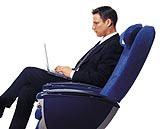High flying profile
British Airways senior design manager Mike Crump flies in the face of negative press reports by striving harder to prove design’s worth. Mike Exon reports

Airline projects are big news, sometimes too big Mike Crump would say.
Take the recent gloom inflicted on the sector in the wake of the World Trade Center attacks, or BA’s ethnic tailfins (which you might just remember). Talk about a media feeding frenzy. The upshot has been that this field of design is having to strive harder than ever to prove its place within the marketing mix.
It won’t have escaped your notice that the contentious BA tailfins are nearly all gone. Not when thanks to the national broadsheets, it was the big design story of last decade. Unfortunately for Crump and his team, Project Utopia as it was called is like a bad recurring dream that won’t go away. Not for a couple more years at any rate, by which time their quiet work with FutureBrand’s David Davies to restore the Britishness of the airline’s identity should be complete.
Of course, the tailfins were (then) BA Design head Chris Holt’s baby and part of a clear brief to target leisure customers for the first time, a fact often overlooked. But as part of the team at that time, Crump felt the blows too. When Holt left post-Utopia, Crump was promoted from heading up product and interiors to manager of the whole setup.
He was born in 1967 and studied industrial design at Brunel University, followed by a masters degree in design management at the Royal College of Art.
‘I guess I realised, coming to the end of my four-year stint as a designer [at Brunel], that I may not be the next Philippe Starck,’ he says, fixing the eye with a smile.
As an undergraduate, he had an enlightening placement at Conran Design Group in the late-1980s.
‘I was lucky enough to work above Heal’s at the peak of the Storehouse era in 1987,’ he says. We were in a design factory basically, with 250 designers churning out products for BHS, Habitat, Mothercare, and so on. I felt a part of this amazing machine. You saw briefs rushed in, designers churning out sketches that were sent off to the Far East for manufacturing. We saw a huge amount of design. I was in the BHS team designing toys, kitchenware, lighting and even point-of-sale displays.’
It was another placement that opened his eyes to management during his time spent studying design management at the RCA.
‘I spent two of the best years of my life at the RCA being sheep-dipped into this creative hub, with floors of designers all doing their own thing – and there was me trying to integrate people and get them to work together,’ he says.
He did a dissertation on ‘managing innovation’ with Thorn EMI, which was keen to use design to forward its technology base. Unfortunately for Crump, who was ‘writing his job description into his dissertation’, Thorn EMI did a U-turn on its decision to set up a design management function. Through a contact, he got a foot in the door at British Airways.
‘I came into the airline in 1991 as a postgraduate placement with all these great ideas – I was going to change the world,’ he recalls.
Crump’s first job on his six-month trial was to put the airline’s brand guidelines on to CD-ROM. BA is PC-based and Crump was one of those rare things in the corporate world a decade ago, a man that could use a Mac. From there he ‘naively’ wrote a radical brief for new seats that needed to be ordered for the first 777 aircraft. It was a chance to design a seat.
‘I suggested design differentiating the customer experience on board, other than through graphics, packaging and branding. In terms of hard product, we hadn’t differentiated ourselves that much. All we had done was take something off the shelf and package it.’
It was the first time design consultancies were given a serious opportunity to design airline seats for BA – Jones Garrard was contracted to design the business seat (which became known as the very successful Cradle Seat, launched in 1993), and also the World Traveller seat.
Crump’s work made an impact and helped secure design’s place as a key component of service differentiation for BA. ‘I raised the excitement levels a bit – we were getting directors in to try out these foam models,’ he recalls
The Cradle Seat was so successful that it was repackaged in 1995 for Club World at the time Design Acumen redesigned BA’s first class seats.
His memories of his early days are still held dear and hark back to a time when design was the talk of the board room. ‘It was a benchmark shift for BA, when we started using design to unlock innovation. We redefined the industry. And it was design that did it.’
Now, however, is not the appropriate time to celebrate the new colour palette of red, white, blue, and silver; the new prominence of the BA speedmarque swoosh, or the tweaked typeface. These things Crump will have signed off in the new brand guidelines within the next couple of weeks. For the first time they will apply to all the airline’s marketing services ‘suppliers’ (even M&C Saatchi).
Implementing them, when you’ve got truckload of old baggage labels in store, will take BA a while. But it’s in no hurry and besides, soft launches are in vogue.
Mike Crump’s CV
Job title: British Airways Senior Design Manager
Boss: Martin George, British Airways marketing and communications director
Born: 1967
Place of birth: Rotherham, South Yorkshire
Education: MDeS Design management, Royal College of Art; BSc (Hons) industrial design, Brunel University
-
Post a comment



